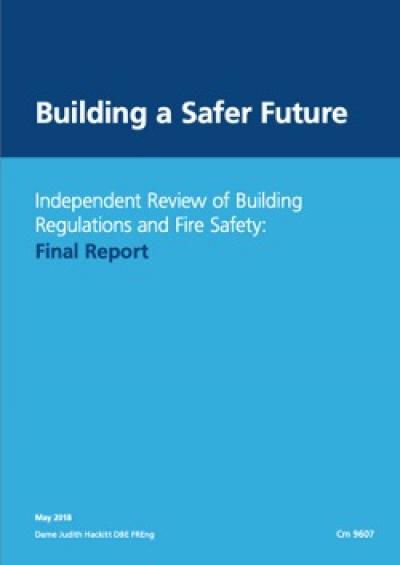Extending limitation periods in the Defective Premises Act 1972: a breach of Article 1 of Protocol No. 1?
Susan Bright is a Professor of Land Law at the University of Oxford and McGregor Fellow of New College. Douglas Maxwell completed a PhD at Cambridge University and starts as a Pupil Barrister in London in September 2021.
Posted:
Time to read:
Section 1 of the Defective Premises Act 1972 (‘DPA’) imposes a duty on a person taking on work for (or in connection with) the provision of a dwelling to see that work is done in a “workmanlike” or “professional manner” so that it is “fit for habitation”. Presently, the limitation period is 6 years from the completion of the dwelling. Many fire safety problems have been discovered too late to enable action.
Clause 126 of the Building Safety Bill (‘BSB’) proposes the retroactive extension of the limitation period under the DPA to 15 years (amendments tabled by Stephen McPartland MP would extend this to 25 years). The Government’s timeline suggests that the earliest time for this to come into force would be early 2023, meaning claims under section 1 of the DPA could be brought for work carried out after 2007. Further, Clause 125 extends the DPA duty to any later work (such as refurbishment) undertaken after this section comes into force.
This post considers whether this retroactive extension could be challenged under Article 1 of Protocol No.1 (‘A1P1’) of the European Convention on Human Rights (‘ECHR’). The idea that human rights arguments might limit leaseholders’ ability to claim for fire safety defects will be uncomfortable for many. Strangely, the BSB provides in Clause 126(5) that:
Where an action is brought that, but for [the extension], would have been barred by the Limitation Act 1980, a court hearing the action must dismiss it in relation to any defendant if satisfied that it is necessary to do so to avoid a breach of that defendant’s Convention rights.

A1P1
A1P1 is a highly qualified right that in substance guarantees the right to property. For A1P1 to be engaged, it must be shown that a victim holds a possession with which there has been an interference. For an interference to be permissible, it must be lawful, in the public interest, and proportionate.
Is A1P1 engaged?
The European Court of Human Rights (‘ECtHR’) has taken an ‘autonomous’ approach to the meaning of ‘possession’ to denote an object of economic value (Broniowski v Poland). The money used to pay a successful claimant under the DPA will likely be considered a ‘possession’.
The case law has drawn distinctions between interferences involving ‘deprivations’ (generally requiring compensation to satisfy the fair balance) and ‘controls of use’ or ‘general interference’ (Sporrong and Lönnroth v Sweden [61]). Clause 126 is one step removed from a deprivation as it simply removes an obstacle to enforcement, and the public interest rationale behind the measure means that if an interference can be shown, it is likely to fall within the scope of a control of use or a general interference (R (British American Tobacco) v Secretary of State ). This is significant as it places an onerous burden on those challenging the retroactive extension of the limitation period to demonstrate that they have been subject to an individual and excessive burden.
Even if A1P1 is engaged, demonstrating a breach is exceedingly difficult.
Has a breach occurred?
Lawfulness
In criminal proceedings, Article 7 of the ECHR reflects the long-standing principle against retrospective laws. While there is no complete prohibition, the principle against retrospective laws also applies in civil law. However, retroactive legislation is not unknown. Challenges are unlikely to succeed merely by reference to generic arguments about retrospective measures.
‘Lawfulness’ requires the measure to have a basis in domestic law and be adequately accessible, precise and foreseeable (Silver v United Kingdom [86]-[88]). The ECtHR is “especially mindful of the dangers inherent in the use of retrospective legislation …, including where the effect is to make pending litigation unwinnable.” (National & Provincial Building Society v United Kingdom [112]). However, the extension of the limitation period under section 1 of the DPA does not impose a new or higher standard. The obligation to pay damages for a wrong is not extinguished by the expiry of a limitation period: limitation renders the obligation unenforceable, and the power to sue is lost (Moses v Macferlan (1760) 2 Bur 1005).
Most potential retroactive fire safety claims under the DPA will concern defects that could have been identifiable when the works were finished. When combined with the margin of appreciation, arguments that Clause 126 is not compatible with the lawfulness standard are unlikely to succeed.
The Public Interest
The separation of powers and the doctrine of the margin of appreciation mean that courts cannot critically review whether a measure is in the public interest unless it is manifestly without reasonable foundation. Given the scale of construction defects, any attempt to argue that Clause 126 is not in the public interest will inevitably fail.
Proportionality
An interference with A1P1 must strike a fair balance and be proportionate. Proportionality requires consideration of whether the measure (1) pursues a legitimate aim; (2) which was rationally connected to that aim; (3) a less intrusive measure could have been used; and (4) whether the ‘fair balance’ is satisfied. At every stage of proportionality review, the decision maker has a margin of appreciation or discretion (Bank Mellat v HM Treasury [74]).
Legitimate aim?
The aim of Clause 126 is to improve building safety and enable those responsible for construction failings to be held to account (an oft-repeated government goal). The courts are unlikely to examine the merits of the aim.

Is it rationally connected to the aim?
A court has to consider whether the limitation period extension is logically capable of advancing the purpose of the BSB. As there is a clear, meaningful connection, this standard appears satisfied.
Could a less intrusive measure have been used?
Parliament is not required to consider every possible alternative. The mere assertion that some other measure is equivalent and less intrusive is not sufficient. Equally, the fact that some other measure can be envisaged is not enough (R (Friends of Antique Cultural Treasures Ltd) v Secretary of State [80]). The evaluation will take account of all relevant circumstances, including those leading to the BSB (for example, the Grenfell Tower Inquiry, Hackitt Review, and the Fire Safety ‘Scandal’), and the reasons given why less restrictive measures were rejected. The discretion given to Parliament, and the detailed legislative scrutiny of the BSB, make it difficult to see how anyone could successfully establish that a less intrusive measure should have been used.
The fair balance
The ‘harm’ caused must be balanced against the potential societal gain. Where the impact has retrospective effect, ‘special justification’ is required (Recovery of Medical Costs for Asbestos Diseases (Wales) Bill). The ECtHR has held that retrospective legislation does not satisfy the fair balance in some cases where the measures extinguished the applicants’ existing claims and negligence had already been established (Pressos v Belgium and Maurice v France) (unlike the proposed DPA change). In contrast, the House of Lords held in AXA General Insurance Ltd v Lord Advocate that a statutory rule which (retrospectively) changed a common law rule to the detriment of insurers was proportionate, giving particular weight to remedying “social injustice”.
The Scottish Law Commission has considered the revival of specific time-barred personal injury claims. Their report on Personal Injury Actions: Limitation and Prescribed Claims concluded that there was a real possibility that the retrospective imposition of liability could contravene A1P1 [5.13]. However, the report stated that "[t]his result is not certain", recognising that retrospective measures can be compatible with A1P1. Two points should be emphasised. The report concerned a very different scenario, looking at injuries sustained much earlier (before 1964). It was also (merely) stating a deferential opinion that a breach was hypothetically possible. Perhaps a similarly cautious approach explains the (unnecessary) inclusion of the human rights qualification in Clause 126(5).

The potential impact on companies is a relevant consideration. They face (among other things): the potential cost of claims, difficulties due to the passage of time, increased problems with professional indemnity insurance and difficulties pursuing contribution claims due to a new disparity between the 6-year limitation period for contractor contracts and claims under the DPA. While these impacts may be significant, demonstrating that they have been subject to an ‘individual and excessive burden’ would probably require more. Especially when balanced against the rights of leaseholders. As such, it is difficult to foresee any court holding that Clause 126 upsets the fair balance.
CONCLUSION
The inclusion of Clause 126(5) may act like a spectre: unjustifiably diluting the changes to the DPA limitation period and deterring potential claimants. Indeed, during the second reading of the BSB, Justin Madders MP stated that the extension of the limitation period would be a ‘field day for the lawyers’. But maybe this bubble will burst. Anyone attempting to challenge Clause 126 using A1P1 is unlikely to succeed.
--
How to cite this blogpost (Harvard style):
Bright, S. and Maxwell, D. (2021) Extending limitation periods in the Defective Premises Act 1972: a breach of Article 1 of Protocol No. 1? Available at: https://www.law.ox.ac.uk/housing-after-grenfell/blog/2021/09/extending-limitation-periods-defective-premises-act-1972-breach (Accessed [date])
Share:
